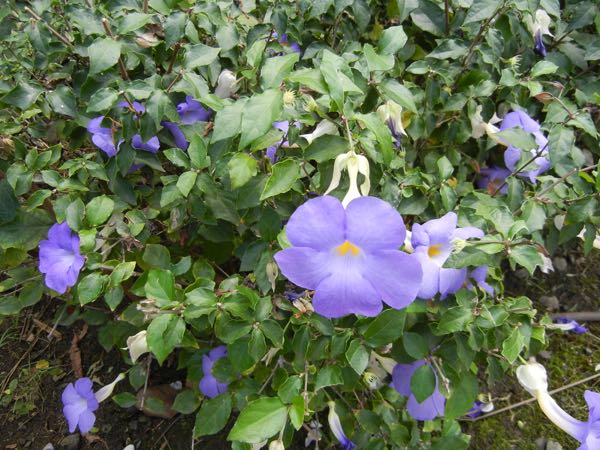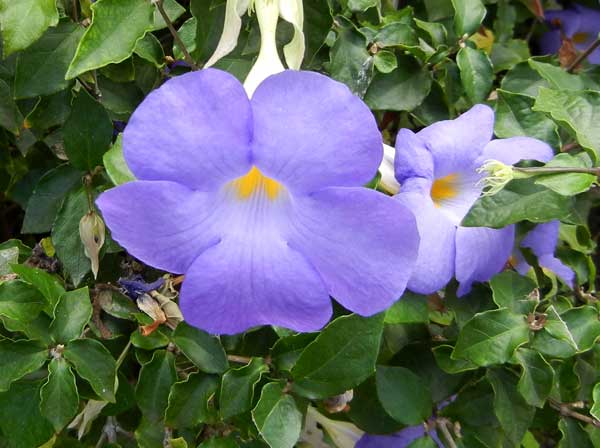Thunbergia erecta ‘Blue Moon’: The Graceful Bush Clockvine
Thunbergia erecta ‘Blue Moon’ also known as the Bush Clockvine, King’s Mantle, Potato Bush, or Sweet Clock Vine, is a captivating plant native to Western Africa. Belonging to the Acanthaceae family of plants, this herbaceous perennial shrub combines the beauty of its flowers and the versatility of its growth habit.
Habitat and Distribution:
Thunbergia erecta is indigenous to Western Africa, where it thrives in the region’s favorable climate and growing conditions. However, it has also found popularity in gardens and landscapes worldwide due to its stunning floral display.
Characteristics:
This erect, herbaceous perennial shrub exhibits an evergreen nature and possesses climbing tendencies. Thunbergia erecta showcases ovate green leaves, providing an attractive backdrop for its blossoms. The flowers of Thunbergia erecta are enchanting with their vibrant violet or purple petals and contrasting white throats. Measuring approximately 1 inch or 2.5 cm in length, these blooms adorn the plant during the summer and autumn seasons. While the fragrance of the flowers is present, it is pleasantly mild, adding a subtle touch to the garden.
How to grow Thunbergia erecta ‘Blue Moon’:
To cultivate Thunbergia erecta ‘Blue Moon’ successfully, consider the following guidelines:
Sun, Soil, and Water Requirements: Grow Thunbergia erecta in a sheltered location that receives ample sunlight or partial shade. It thrives in well-drained soil that allows excess water to escape easily. While this plant appreciates regular watering, it is also drought-tolerant once it is established, making it a resilient choice for various garden environments.
Growth Habit and Maintenance: Thunbergia erecta can reach a height of up to 6 feet or 1.8 meters, showcasing its potential as a vertical accent in the garden. Its vigorous growth and climbing nature make it an excellent choice for trellises or arbors. This plant is relatively easy to maintain, being generally pest-free and disease-free. Pruning is typically unnecessary, except for occasional shaping or the removal of spent flowers through deadheading.
Propagation: Thunbergia erecta can be propagated through layering or cuttings. Layering involves burying a portion of a low-growing stem to encourage root development, while cuttings involve taking a piece of stem and rooting it in a suitable medium. Both methods can be successful in producing new plants and expanding your Thunbergia erecta collection.
Pest and Disease Information:
Thunbergia erecta ‘Blue Moon’ is generally considered a resilient and relatively pest-free plant. However, it is still important to be aware of potential issues that may arise. Here are some common pests and diseases that can affect Thunbergia erecta:
- Aphids: Aphids are small, sap-sucking insects that can infest the leaves and stems of Thunbergia erecta. They can cause stunted growth and distortion of plant tissues. Use insecticidal soap or a strong stream of water to control aphid populations.
- Whiteflies: Whiteflies are tiny insects that feed on the sap of plants, causing yellowing of leaves and sticky honeydew residue. They can be controlled by using insecticidal soap or horticultural oils.
- Spider Mites: Spider mites are common pests that can cause yellowing, stippling, and webbing on the leaves of Thunbergia erecta. Regularly inspect the plant for signs of spider mite infestation and use miticides or insecticidal soap to control them.
- Powdery Mildew: Powdery mildew is a fungal disease that can affect Thunbergia erecta, especially in humid conditions. It appears as a white powdery coating on the leaves stems, and flowers. To prevent powdery mildew, provide adequate air circulation and avoid overhead watering. Fungicidal sprays may be used to treat severe infections.
- Leaf Spot: Leaf spot diseases, caused by various fungal pathogens, can cause dark, circular spots on the leaves of Thunbergia erecta. Remove and destroy infected leaves and ensure proper spacing between plants to improve air circulation and reduce humidity.

It’s important to regularly monitor your Thunbergia erecta plants for any signs of pest infestation or disease. Prompt action, such as appropriate cultural practices and targeted treatments, can help maintain the health and vigor of the plant.
By incorporating Thunbergia erecta ‘Blue Moon’ into your garden, you can enjoy its graceful presence and charming flowers. Its versatility, resilience, and low maintenance requirements make it an ideal choice for gardeners seeking a plant that combines aesthetic appeal with ease of cultivation.
Also, read about Thunbergia alata




